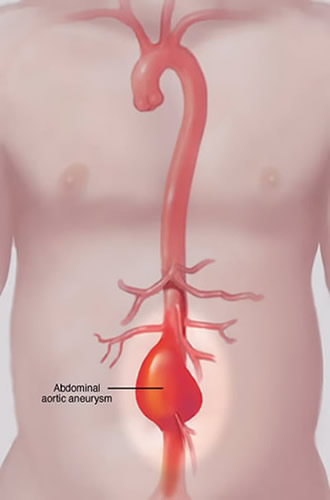An abdominal aortic aneurysm could be significant, an emergency condition when it has become advanced. While it can be serious (especially if it ruptures), fortunately it is also treatable if caught early. Some effective treatments are available to cope with it. If you do concern about your risk of this swelling disorder – it’s important to understand the symptoms, risk factors, and treatment options so you can take action quickly if needed!
What actually is abdominal aortic aneurysm?
Aneurysm means swelling – so abdominal aortic aneurysm (AAA) is a condition of when the abdominal aorta, the lower part of the major blood vessel that runs through your abdomen, gets swelled.
Normally, the size of abdominal aorta is about 0.79 inches (2 cm) wide, about the thickness of a garden hose. In advanced AAA, it can enlarge over 2.7 inches (5.5 cm).
*Image credit to Mayo
Causes and risk factors
Currently, it’s not known yet what exactly causes this disorder. But doctors believe that the following factors or conditions may play a role.
- Tobacco smoke. It is thought that cigarette smoking raises the risk of the condition. Tobacco smoke can hurt your aorta, making the aorta’s walls weaken. The more you smoke, the greater risk of developing aneurysm in your aorta!
- High blood pressure (hypertension). High pressure against blood vessels (including aorta) can weaken and damage the blood vessel’s walls. And weakened aorta’s walls are easier to get swelled.
- A condition called atherosclerosis, hardening of the arteries. It can develop when excess deposits (such as fat, cholesterol, and other substances) accumulate and build up on the lining of the blood vessels. If it occurs in the abdominal aorta, over time it may lead to AAA.
- In some cases, AAA can occur due to a consequence of disease or infection in the aorta.
- It’s also thought that AAA runs in families. Research suggests that having first relative degrees (particularly such as sister or brother with AAA) may significantly increase the risk of developing the same condition.
- Trauma, such as after a car accident.
In addition, it seems that the risk of developing AAA also increases with age. In fact, it is relatively more common in people aged 50 or older.
So in general, abdominal aortic aneurysm occurs when the abdominal aorta’s wall becomes weakened and the large volume of blood that flow through it puts more pressure, making it to bulge outwards and get swelled.
Symptoms
AAA may vary from patient to patient. But most of the time, it grows slowly and develops gradually. Therefore it often doesn’t cause early symptoms and difficult to catch early.
Over time it can rupture, though not always. In some cases, it starts small and stays small. But it also can expand and eventually may rupture. In a few cases, it also can expand more quickly. Unfortunately, it’s still difficult to predict how fast it may enlarge.
As it enlarges, it may cause some of the following symptoms:
- Back pain that is difficult to improve, persistent back pain.
- Constant, deep stomach pain. You may also feel it on the side of the abdomen.
- A pulsating feeling in your abdomen, typically near the navel (belly button). It’s usually more noticeable when you touch it.
If it ruptures, it can cause severe and sudden pain in the abdomen (particularly in the side or middle of the abdomen). The pain may also radiate down into scrotum (in men) or even to legs.
The ruptured AAA is painful and may also be followed with other symptoms such as; nausea, vomiting, clammy /sweaty skin, dizziness, tachycardia (increased heartbeat), feeling of breathlessness, or even loss of consciousness.
Why is an abdominal aortic aneurysm significant?
AAA is usually not noticeable until it becomes advanced. Again if you have it, you probably won’t notice anything different. But if it bursts, it can be a medical emergency and you should go to the hospital as soon as possible! Even ruptured AAA can cause a death.
The effect of ruptured AAA can be very serious. Therefore, screening for AAA is recommended to catch it as early as possible (when it is usually most treatable) – especially for people with many risk factors of the condition.
But why is ruptured AAA very significant and even life-threatening?





